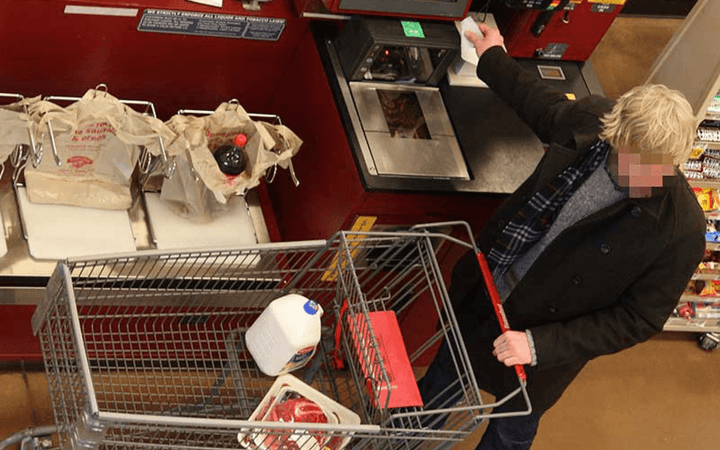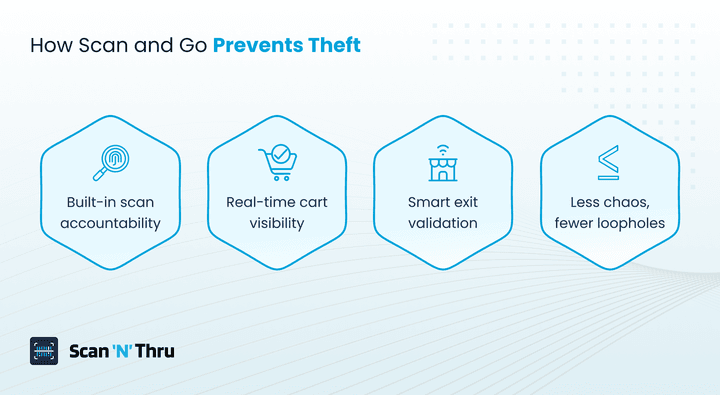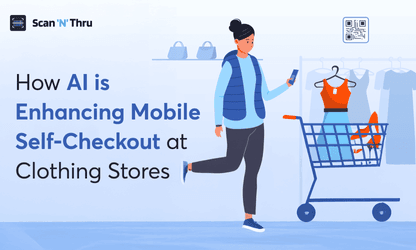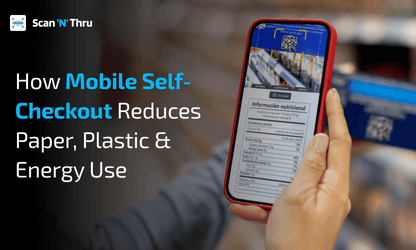Theft in retail stores is more common than most retailers realize. Sometimes, it’s quieter. Slower. Hidden inside a jacket or mislabeled at a kiosk. And it adds up fast.
Supermarkets, convenience stores, and high-volume retailers lose billions each year to external theft.
Most thefts happen during checkout, especially in stores where self-scanning machines are implemented. And this is where usually no one’s watching.
Self-checkout technology is effective in reducing queues and bottlenecks, but it’s not that effective when it comes to retail theft prevention.
Traditional loss prevention tactics like CCTV and security tags help, but they rarely stop the act before it happens.
If theft is quietly eroding your margins, maybe it’s time to look at how your checkout system plays a role and how scan and go technology can help you prevent that.
Here’s what you’ll learn in this blog:
-
The most common types of external retail theft (and why they’re hard to catch)
-
Why self-checkout kiosks fall short as a theft prevention tool
-
How scan and go creates a smarter, frictionless, and theft-resistant shopping experience
Let’s begin!
The growing cost of retail theft
Theft is a hard cost to ignore, especially when it’s normalized as “shrink.” But what’s often called shrinkage is, in most cases, theft. And external theft now accounts for a large chunk of that loss.
As per Extenda Retail, customer shoplifting accounts for 37% of shrinkage. That is the most among all types of shrinkage.
Retailers like you already battle tight margins, rising labor costs, and shifting shopper expectations.
Considering all that, preventing theft isn’t just about catching shoplifters; it’s about protecting your business from unnecessary losses that fly under the radar.
How theft happens in stores today
Most retail theft is opportunistic. It’s not pulled off by professionals. It’s done by regular people who see a gap and take advantage of it. And—as mentioned in the beginning— many of those gaps exist at checkout.
Shoplifting and concealment
This is perhaps the oldest trick in the book. Shoppers hide items in bags, strollers, or under clothing. Sometimes they distract staff. Other times, they just walk confidently out with unpaid items.
Price tag switching
This one’s subtle but effective. Someone takes the barcode from a cheaper item and sticks it on a more expensive product.
This kind of theft happens in stores where self-checkout stations are in place, it scans without issue, and nobody notices.
Partial scan walkouts
Customers at kiosks sometimes scan a few items and intentionally skip the rest. Some fake a scan by waving the barcode near the reader without actually registering it. In busy stores, it’s easy to get away with.
Why traditional security can’t keep up
You’ve seen the setup: cameras, EAS gates, mirrors, and security staff. These tools help, but only after something’s already been stolen. They’re reactive, not preventive.
Apart from that, bag checks and staff surveillance might catch the occasional thief, but they also frustrate honest customers. And they’re expensive to maintain.
Hence, retailers like you don’t just need security; you need smart deterrents built into the shopping experience itself.
Why self-checkout systems aren’t effective in theft prevention
No doubt, kiosks are designed to speed up checkout, cut costs, and boost operations. But they’ve created new problems. And theft from self checkouts is one of the major ones.

A customer is caught shoplifting in a store with self-checkout kiosks
Self-checkout kiosks operate in a gray zone. That means they’re often placed near store exits with minimal supervision.
Besides, it is nearly impossible for your staff to realistically watch every screen or customer. That gives shoplifters an open invitation.
Worse, kiosks offer zero customer-level traceability. There's no identity tied to the transaction, so there's little accountability. And when the store is busy, it becomes chaotic, making it easier to walk away unpaid.
Read more - Self-checkout kiosks vs mobile self-checkout: which one is better for your retail store?
Self-checkout theft statistics
Below are a few statistics on self-checkout theft based on recent data:
Self checkout theft rates are significantly higher than traditional checkout:
-
Shrink rates at self-checkout average 3.5% of sales, which is more than 16 times higher than the 0.21% shrink rate at traditional cashier lanes. (Grabango)
-
Self-checkout is responsible for a shrink rate that is more than 16 times higher than traditional cashier lines. (grabango)
Prevalence and consumer behavior:
-
37% of shoppers admit to self checkout stealing. (Serve Legal)
-
About 20.1 million Americans have stolen from a self-checkout kiosk, and 8.85 million say they plan to do it again. (Capital One Shopping)
-
69% of consumers believe it’s easier to steal from self-checkout than from a cashier. (LendingTree)
-
Only 13% of people think it’s difficult to steal from self-checkout; over half say it’s easy or very easy. (Loss Prevention Media)
Detection and repeat offenses:
-
Only 33% of self-checkout shoplifters have been caught. (Capital One Shopping)
-
44% of those who have stolen say they’ll likely do it again. (Loss Prevention Media)
How scan and go prevents theft
Scan and go technology isn’t just a better checkout method. It’s a smarter theft prevention tool because it changes how customers interact with your store.
Let’s see how it can help in retail theft prevention:

Built-in scan accountability
Unlike self-checkout machines, scan and go systems operate through smartphones. That means every transaction is linked to a user account, loyalty ID, or phone number. The moment a shopper logs in or scans, there’s a digital trail.
This alone deters casual theft. Customers know they’re not anonymous. And that awareness changes behavior.
Real-time cart visibility
As items are scanned, they’re tracked in a digital cart. Retailers can see patterns: skipped scans, duplicate barcodes, or unusual scan speeds. Any red flags can trigger automatic alerts.
This system doesn’t require someone watching over every shoulder. The technology monitors behavior quietly in the background.
Smart exit validation
Scan and go allows stores to implement light-touch verification at exits—QR-based receipt checks, auto-open gates, or random spot verifications. This layer makes walkouts riskier for would-be thieves without bothering honest customers.
It’s subtle. It works. And it keeps the checkout experience smooth for those doing the right thing.
Less chaos, fewer loopholes
Unlike kiosks, scan and go apps eliminate the bottleneck.
When customers use these apps, there’s no shared terminal, no lines, and no pressure to scan quickly. That alone reduces errors and theft opportunities. When shoppers control the pace, they focus more, and that leads to more honest shopping and transactions.
How scan and go changes shopper intent
One of the most underrated benefits of scan and go solutions is how they change intent.
People steal when they believe there’s no risk. In the case of self-scanning kiosks, customers are unknown to the system, and no one’s watching. So, the risk feels low.
But when every scan is tied to their device, their name, and their behavior, risk perception skyrockets.
And that’s often enough to stop the act before it happens. Most people are ashamed of getting caught. So, it’s likely they won’t risk it.
Can scan and go prevent unscanned items?
Many retailers like you often ask this. And it’s a fair concern.
The short answer is that yes, people can choose not to scan products. But the difference lies in what happens after.
With scan and go systems:
-
You have a record of what was scanned and when.
-
You can flag suspicious patterns over time (e.g., low-value carts from the same user).
-
You can use AI to analyze behaviors, compare averages, and identify potential theft.
Hence, you’re not just reacting after the fact. You’re building an intelligent prevention system.
Final Thoughts: Preventing theft without creating friction
Theft prevention shouldn’t turn your store into a surveillance zone. And it shouldn’t make honest customers feel uncomfortable.
That’s exactly where Scan ‘N’ Thru stands out.
It’s not just another mobile self-scanning tool; it’s a mobile-first system built with real-time visibility, customer accountability, and seamless built-in exit validation.
With this scan and go solution, every scan is tied to a shopper’s identity. Every transaction is trackable. And every suspicious pattern can be flagged before losses snowball.
While traditional self-checkout kiosks leave too many blind spots, Scan ‘N’ Thru gives you full visibility without slowing customers down or making them feel watched. It helps you:
-
Reduce theft opportunities
-
Remove friction from the checkout process
-
Create a shopping experience that feels modern, safe, and intuitive
If you’re looking to lower shrink without increasing overhead or hurting honest shoppers, Scan ‘N’ Thru is worth a closer look.




